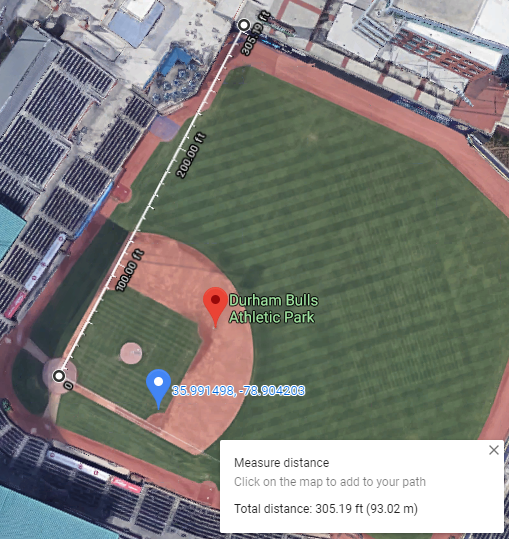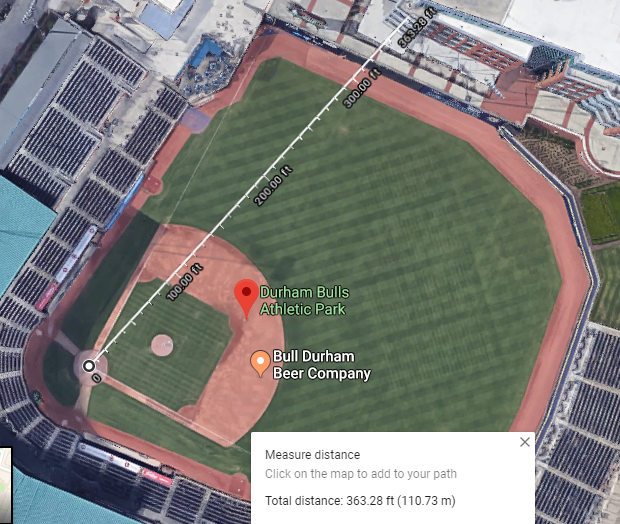How Far Did Giancarlo Stanton Hit This Baseball?

Sometimes we don’t realize the impact of absence until the return. The February cold doesn’t seem so unbearable until you think about it in June. Even though you were freezing at the time, you had little choice but to trick yourself into thinking all was well.
In this sense, the Yankees haven’t missed Giancarlo Stanton. It’s not they didn’t feel his absence. They’re winning plenty of baseball games without him, staying neck-and-neck with the Rays. They can rationalize that they’ve been fine without him.
However, the unspeakable things Stanton can do to a midle-in fastball are simply irreplaceable. On Friday evening, while rehabbing for Triple-A Scranton-Wilkes Barre on the road in Durham, he reminded the Yankees what they’ve been missing.
Not too many baseballs reach the highest blue lightboard in Durham. Make no mistake about it, that is a monster blast.
Unfortunately, just as the fish doesn’t notice the water until it’s on land, we also don’t appreciate luxuries and necessities until they’re gone. Five years ago, we didn’t have Statcast to provide the distance, exit velocity, and launch angle of every batted ball in real time. We’ve grown accustomed to learning the precise details of every home run immediately.
There is no Statcast in Durham. Such a majestic dinger deserves the full treatment, but we have no idea if Stanton crushed that pitch 105 mph or 120. At the very least, we need an estimated distance. Not knowing how far a homer traveled is soooo 2014!
Time to Estimate!
Fortunately, this is 2019 after all, and we have some modern technology at our disposal- namely Google Maps. Here is the satellite view of Durham Bulls Athletic Park:

Using the distance tool, Google measures the left field foul pole distance at 305.19 ft. According to the given park dimensions, it is in fact 305 ft. down the line, so Google is right on the money.
Speaking of the ballpark, it’s important to note that it’s a bandbox. 305 down the line is already short, but it juts straight out towards left center. The stadium was modeled after Fenway Park in Boston, and the 32-foot high wall is named The Blue Monster.
There isn’t a ballpark in the world that could’ve contained Stanton’s blast. However, context is important. In a stadium with a deeper wall in left, such as Yankee Stadium, the ball wouldn’t have surpassed it by as much.
363. 363?
Does that mean the ball didn’t travel as far as it seemed? Here’s where the Stanton home run terminated:

Anyone who’s watched a decent amount of baseball knows 363 ft. just doesn’t past the eye test. In Pittsburgh’s PNC Park, that might even be a fly out! No, we’ve got more math to do.
The problem with Google’s estimated distances is that it doesn’t account for height. Take a look at this screenshot of the outfield wall:

This is all rough estimation, but the 32 ft. high wall is about 31.3 percent of the height from the base to the top of the highest blue lightboard where the ball struck. Therefore, it terminated not just 363 ft. from home plate, but 102.4 ft. above the playing surface.
We can use this information to help us guess the remaining distance the ball would have traveled. However, we have to take a guess at the angle of approach. Let’s assume the ball was crashing down at about a 60-degree angle. This could be wildly inaccurate; there’s no real way of checking. Just roll with it.
Using a handy triangle calculator, we can estimate how much farther the ball would have traveled had the building not been in the way.

Adding on another 59 ft., the total estimated distance is 422 ft. That’s a much more reasonable than 363 ft.
Are We Still Impressed?
A 422 ft. home run is pretty sweet, but it’s hardly Stantonian. Giancarlo has hit 71 baseballs farther than that since 2015, including three against Jacob deGrom!
Here is the longest home run he has ever smashed- a 504 ft. bomb against Chad Bettis in 2016 at Coors Field (of course):
Certainly, it’s a phenomenal home run. It lands about fifteen rows up in left-center. However, it just doesn’t seem as magnificent as the Durham blast, even though it landed 84 ft. farther. (Again, this is an estimated distance, and probably not even a very good estimation, either.)
Such is the importance of context. Durham’s stadium is relatively microscopic, whereas Coors is huge. It’s hard just to hit a wall-scraper to that part of the park (never mind the thin air above Denver).
In this case, maybe we’re better off without Statcast. Now that you know the dimensions in Durham, you’re probably less impressed by the home run. It was still fun to watch though, especially for Yankee fans who hadn’t realized how much they missed him in the lineup.




















